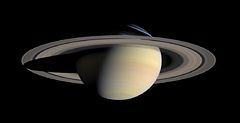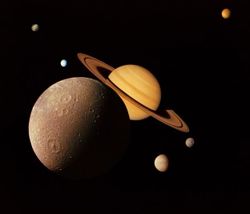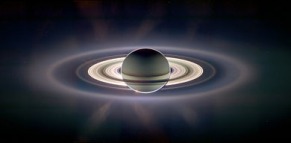Saturn

Saturn is the sixth planet from the Sun and the second largest planet in the Solar System, after Jupiter. Along with the planets Jupiter, Uranus and Neptune it is classified as a gas giant (also known as a Jovian planet, after the planet Jupiter). It was named after the Roman god Saturnus, equated to the GreekKronos (the Titan father of Zeus) and the Babylonian Ninurta. Saturn's symbol represents the god's sickle (Unicode: ♄).
The planet Saturn is composed of hydrogen, with small proportions of helium and trace elements.[10] The interior consists of a small core of rock and ice, surrounded by a thick layer of metallic hydrogen and a gaseous outer layer. The outer atmosphere is generally bland in appearance, although long-lived features can appear. Wind speeds on Saturn can reach 1,800 km/h, significantly faster than those on Jupiter. Saturn has a planetary magnetic field intermediate in strength between that of Earth and the more powerful field around Jupiter.
Saturn has a prominent system of rings, consisting mostly of ice particles with a smaller amount of rocky debris and dust. Sixty known moons orbit the planet. Titan, Saturn's largest and the Solar System's second largest moon (after Jupiter's Ganymede), is larger than the planet Mercury and is the only moon in the Solar System to possess a significant atmosphere.[11]
Moons of Saturn

Saturn has 60 named natural satellites, many of which were discovered only recently and may be as small as two-to-three kilometers across, plus hundreds of observed "moonlets" only a few tens or hundreds of meters across in the A Ring. Seven of the moons are large enough to have achieved hydrostatic equilibrium and so would be considered dwarf planets if they were in orbit about the Sun; indeed one of them, Titan, is massive enough to retain an atmosphere denser than our own. A precise number of moons can not be given, as there is no objective boundary between the countless small anonymous objects that form Saturn's ring system and the larger objects that have been named as moons.
Rings of Saturn

The rings of Saturn are a system of planetary rings around the planet Saturn. They consist of countless small particles, ranging in size from microns to meters, that form clumps that in turn orbit about Saturn. The ring particles are made almost entirely of water ice, with some contamination from dust and other chemicals.
Although reflection from the rings increases Saturn's brightness, they are not visible from Earth with unaided vision. In 1610, the year he first turned a telescope to the sky, Galileo Galilei became the very first person to observe Saturn's rings, though he could not see them well enough to discern their true nature. In 1655, Christiaan Huygens was the first person to describe them as a disk surrounding Saturn.[1]
Although many people think of Saturn's rings as being made up of "countless tiny ringlets" (a concept that goes back to Laplace), true gaps are few in number. It is more correct to think of the rings as an annular disk with concentric local maxima and minima in density and brightness. On the scale of the clumps within the rings there is a lot of empty space, but in general these empty spaces are discontinuous.
There are several gaps within the rings: two opened by known moons embedded within them, and many others at locations of known destabilizing orbital resonances with Saturn's moons. Other gaps remain unexplained. Stabilizing resonances, on the other hand, are responsible for the longevity of several rings, such as the Titan Ringlet and the G Ring.
